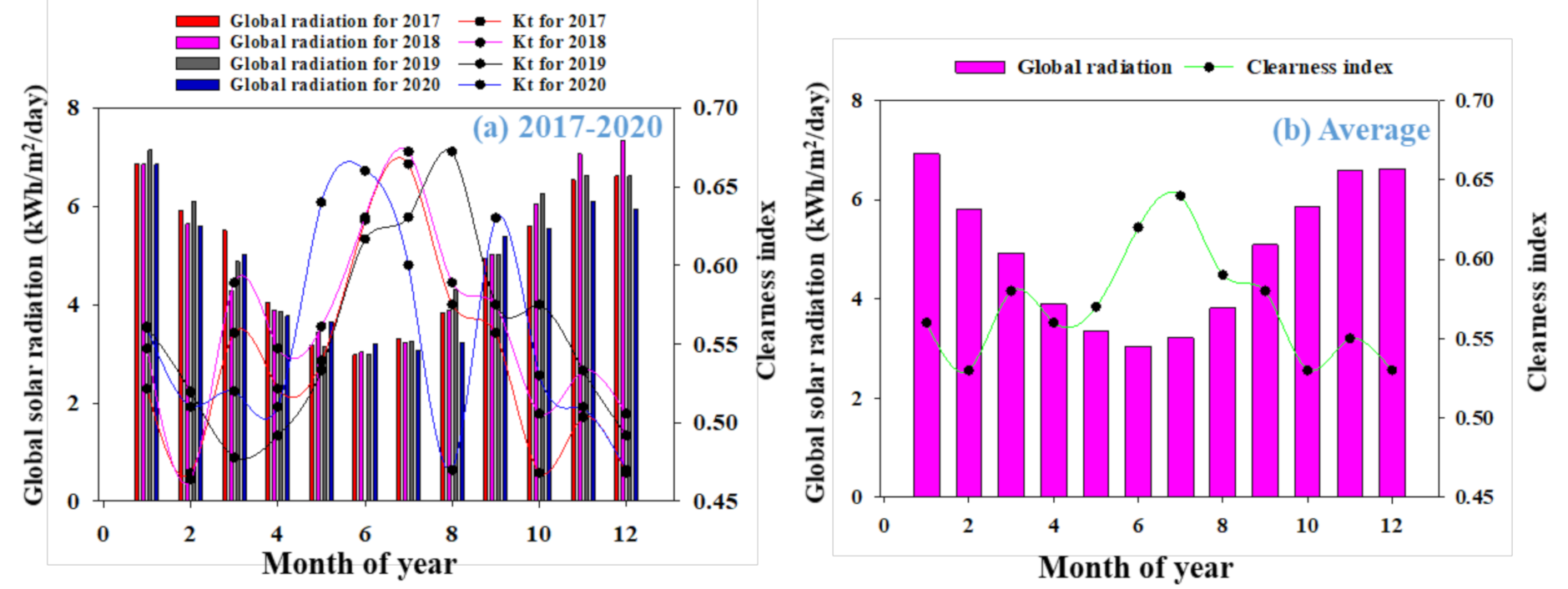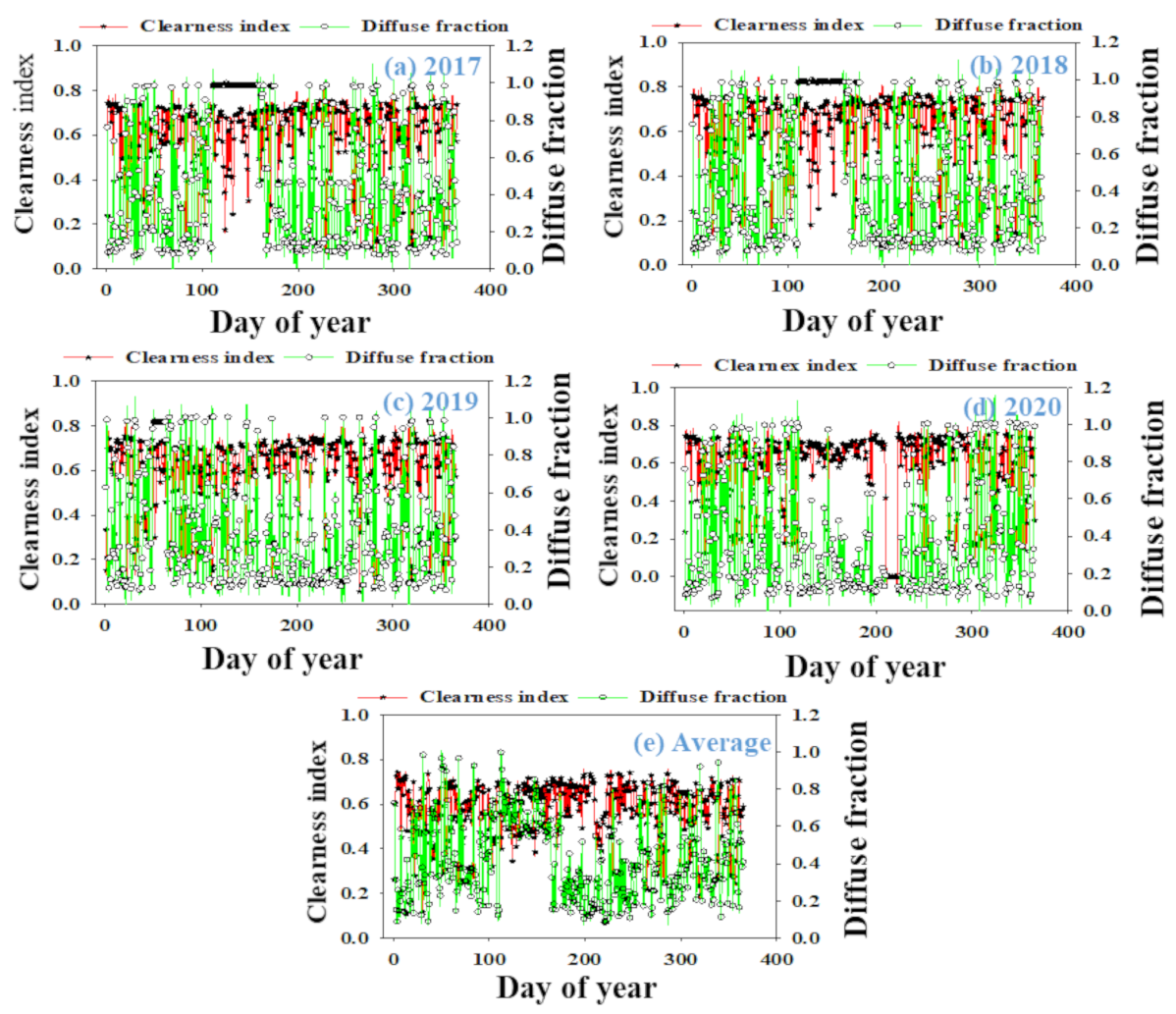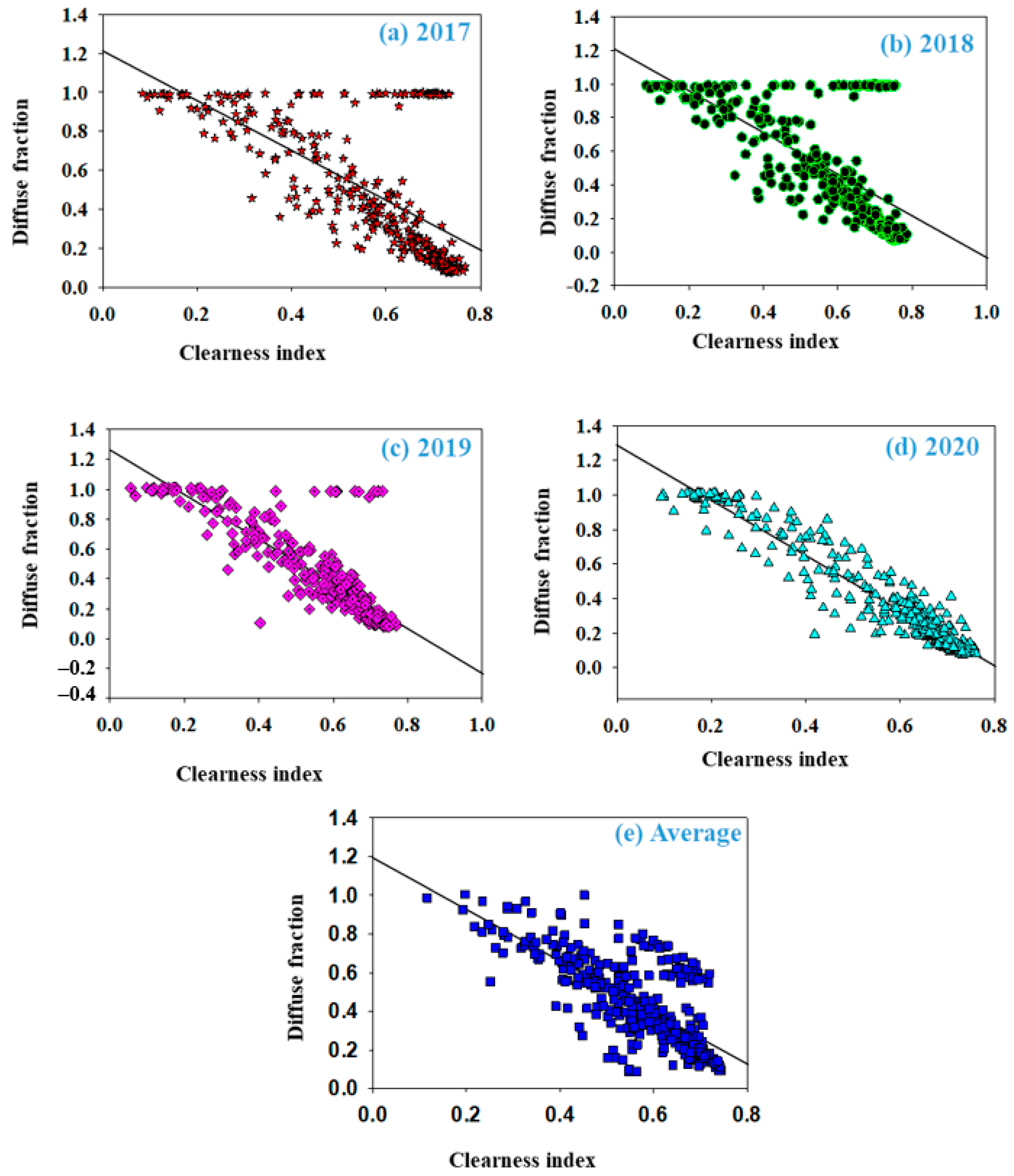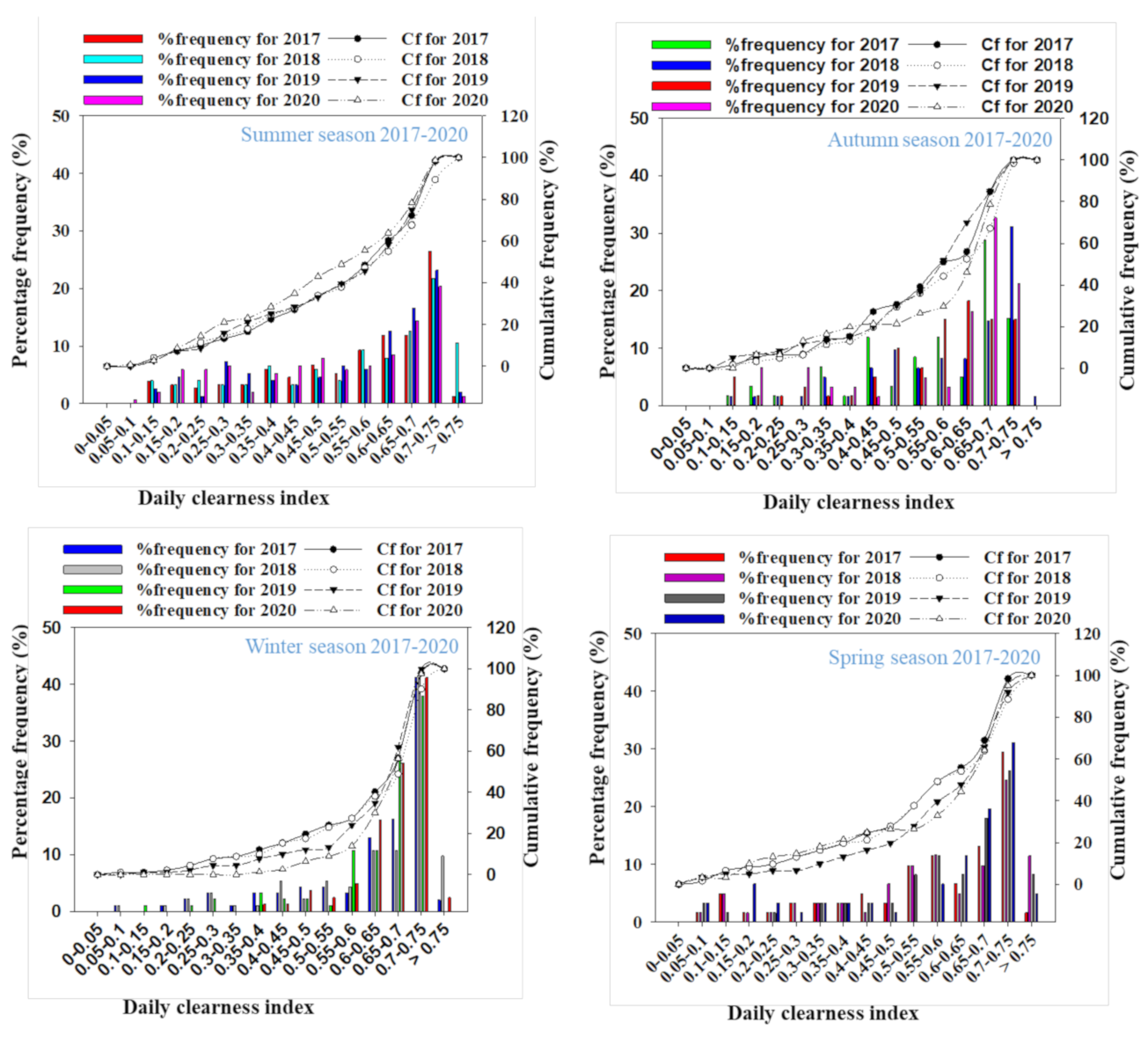Monthly, Seasonal and Yearly Assessments of Global Solar Radiation, Clearness Index and Diffuse Fractions in Alice, South Africa
Abstract
1. Introduction
1.1. The Study Location and Meteorological Features
1.2. Descriptions of Sky Conditions
2. Materials and Methods
2.1. Data and Instrumentations
2.2. Estimation of Extra-Terrestrial Radiations, Clearness Index and Diffuse Fraction on a Horizontal Surface
2.2.1. Extra-terrestrial Radiations (Ho)
2.2.2. Correlation of Clearness Index and Diffuse Fraction
3. Results and Discussion
3.1. The Monthly, Seasonal, and Annual Variations of Clearness Index and Diffuse Fraction
3.2. Regression Correlation between Kd and Kt
3.3. Frequency and Commutative Frequency Distribution of Daily Kt Values
4. Conclusions
Author Contributions
Funding
Institutional Review Board Statement
Informed Consent Statement
Data Availability Statement
Acknowledgments
Conflicts of Interest
References
- Chen, Z.; Ivan Su, S.I. Dual competing photovoltaic supply chains: A social welfare maximization perspective. Int. J. Environ. Res. Public Health 2017, 14, 1416. [Google Scholar] [CrossRef] [PubMed]
- Zhang, X.; Zhao, X.J.; Li, Y. Analysis of sky conditions using 40 year records of solar radiation data in China. Theor. Appl. Climatol. 2007, 89, 83–94. [Google Scholar]
- Ghazi, S.; Ip, K. The effect of weather conditions on the efficiency of PV panels in the southeast of UK Renew. Energy 2014, 69, 50–59. [Google Scholar]
- Fedorov, V.M. Earth insolation variation and its incorporation into physical and mathematical climate models. Uspekhi Fiz. Nauk 2019, 189, 33–46. [Google Scholar] [CrossRef]
- Meyer, E.L.; Overen, O.K. Blue skies and red sunsets: Reliability of performance parameters of various p-n junction photovoltaic module technologies. Cogent Eng. 2019, 6, 1–20. [Google Scholar] [CrossRef]
- Stokes, G.M.; Schwartz, S.E. The Atmospheric Radiation Measurement (ARM) Program: Programmatic background and design of the cloud and radiation test bed. Bull. Am. Meteorol. Soc. 1994, 75, 1201–1221. [Google Scholar] [CrossRef]
- Okogbue, E.C.; Adedokun, J.A. The estimation of solar radiation at Ondo, Nigeria. J. Phys. 2002, 14, 97–99. [Google Scholar]
- Ayodele, T.R.; Ogunjuyigbe, A.S.O. Prediction of monthly average global solar radiation based on statistical distribution of clearness index. Energy 2015, 90, 1733–1742. [Google Scholar] [CrossRef]
- Liu, B.Y.H.; Jordan, R.C. The interrelationship and characteristic distribution of direct, diffuse and total solar radiation. Sol. Energy 1960, 4, 1–19. [Google Scholar] [CrossRef]
- Udo, S.O. Sky conditions at Ilorin as characterized by clearness index and relative sunshine. Sol. Energy 2000, 69, 45–53. [Google Scholar] [CrossRef]
- Berrizbeitia, S.E.; Gago, E.J.; Muneer, T. Empirical models for the estimation of solar sky-diffuse radiation. A review and experimental analysis. Energies 2020, 13, 701. [Google Scholar] [CrossRef]
- Govindasamy, T.R.; Chetty, N. Quantifying the global solar radiation received in Pietermaritzburg, KwaZulu-Natal to motivate the consumption of solar technologies. Open Phys. 2018, 16, 786–794. [Google Scholar] [CrossRef]
- Maleki, S.A.M.; Hizam, H.; Gomes, C. Estimation of hourly, daily and monthly global solar radiation on inclined surfaces: Models re-visited. Energies 2017, 10, 1. [Google Scholar]
- Boland, J.; Huang, J.; Ridley, B. Decomposing global solar radiation into its direct and diffuse components. Renew. Sustain. Energy Rev. 2013, 28, 749–756. [Google Scholar] [CrossRef]
- Liu, D.L.; Scott, B.J. Estimation of solar radiation in Australia from rainfall and temperature observations. Agric. For. Meteorol. 2001, 106, 41–59. [Google Scholar] [CrossRef]
- Okogbue, E.C.; Adedokun, J.A.; Holmgren, B. Hourly and daily clearness index and diffuse fraction at a tropical station, Ile-Ife, Nigeria. Int. J. Climatol. A J. R. Meteorol. Soc. 2009, 29, 1035–1047. [Google Scholar] [CrossRef]
- Buma, C.; Meyer, E.; Taziwa, R.T. Energy Management in the Balance of System Components in a Stand-Alone Building Integrated Photovoltaic System in Alice, South Africa. January 2018. Available online: https://www.researchgate.net/profile/Carine_Buma2/publication/322599798_ENERGY_MANAGEMENT_IN_THE_BALANCE_OF_SYSTEM_COMPONENTS_IN_A_STAND-ALONE_BUILDING_INTEGRATED_PHOTOVOLTAIC_SYSTEM_IN_ALICE_SOUTH_AFRICA/links/5a61eb11a6fdccb61c504bfa/ENERGY-MANAGEMENT-IN-THE-BALANCE-OF-SYSTEM-COMPONENTS-IN-A-STAND-ALONE-BUILDING-INTEGRATED-PHOTOVOLTAIC-SYSTEM-IN-ALICE-SOUTH-AFRICA.pdf (accessed on 8 February 2021).
- Meyer, E.L.; Buma, C.L.; Taziwa, R.T. Performance parameters of an off-grid building integrated photovoltaic system in South Africa. Proceedings of 33rd European Photovoltaic Solar Energy Conference and Exhibition, Amsterdam, The Netherland, 23–29 September 2017; pp. 2450–2455. [Google Scholar]
- Overen, O.K.; Meyer, E.L.; Makaka, G.; Ziuku, S.; Mamphweli, S. Zonal air exchange rate of a passive solar house and resultant sensible air heat transfer. Indoor Built. Environ. 2018, 28, 1–13. [Google Scholar] [CrossRef]
- Ziuku, S.; Meyer, E.L. Implementing building integrated photovoltaics in the residential sector in South Africa. J. Energy South. Afr. 2008, 24, 1–10. [Google Scholar]
- Hoare, D.B.; Bredenkamp, G.J. Grassland communities of the Amatola/Winterberg mountain region of the Eastern Cape, South Africa. S. Afr. J. Bot. 1999, 65, 75–82. [Google Scholar] [CrossRef]
- SABS. SANS 204:2011—South African National Standard: Energy Efficiency in Buildings; SABS Standards Division: Pretoria, South Africa, 2011; Volume 1. [Google Scholar]
- Tadross, M.; Johnston, P. Climate Systems Regional Report: Southern Africa; ICLEI—Local Governments for Sustainability—Africa Climate Systems Regional Report: Southern Africa; ICLEI—Local Governments for Sustainability—Africa: Pretoria, South Africa, 2012.
- Alonso-Montesinos, J.; Batlles, F.J. Solar radiation forecasting in the short and medium-term under all sky conditions. Energy 2015, 83, 387–393. [Google Scholar] [CrossRef]
- Lai, C.S.; Li, X.; Lai, L.L.; McCulloch, M.D. Daily clearness index profiles and weather conditions studies for photovoltaic systems. Energy Procedia 2017, 142, 77–82. [Google Scholar] [CrossRef]
- Tongwane, M.I.; Savage, M.J.; Tsubo, M. Relationship between global and diffuse irradiance and their variability in South Africa. Theor. Appl. Climatol. 2015, 137, 1027–1040. [Google Scholar] [CrossRef]
- Fluri, T.P. The potential of concentrating solar power in South Africa. Energy Policy 2009, 37, 5075–5080. [Google Scholar] [CrossRef]
- Loutzenhiser, P.G.; Manz, H.; Felsmann, C.; Strachan, P.A.; Frank, T.; Maxwell, G.M. Empirical validation of models to compute solar irradiance on inclined surfaces for building energy simulation. Sol. Energy 2007, 81, 254–267. [Google Scholar] [CrossRef]
- Nwokolo, S.; Otse, C. Impact of Sunshine Duration and Clearness Index on Diffuse Solar Radiation Estimation in Mountainous Climate. Trends Renew. Energy 2019, 5, 307–332. [Google Scholar] [CrossRef]
- Meyer, E.L.; Apeh, O.O.; Overen, O.K. Electrical and meteorological data acquisition system of a commercial and domestic microgrid for monitoring pv parameters. Appl. Sci. 2020, 10, 9092. [Google Scholar] [CrossRef]











| Description of Sky | Range |
|---|---|
| Clear | 0.7 ≤ Kt ≤ 0.9 |
| Partially cloudy | 0.3 ≤ Kt ≤ 0.7 |
| Cloudy | 0.0 ≤ Kt ≤ 0.3 |
Publisher’s Note: MDPI stays neutral with regard to jurisdictional claims in published maps and institutional affiliations. |
© 2021 by the authors. Licensee MDPI, Basel, Switzerland. This article is an open access article distributed under the terms and conditions of the Creative Commons Attribution (CC BY) license (http://creativecommons.org/licenses/by/4.0/).
Share and Cite
Apeh, O.O.; Overen, O.K.; Meyer, E.L. Monthly, Seasonal and Yearly Assessments of Global Solar Radiation, Clearness Index and Diffuse Fractions in Alice, South Africa. Sustainability 2021, 13, 2135. https://doi.org/10.3390/su13042135
Apeh OO, Overen OK, Meyer EL. Monthly, Seasonal and Yearly Assessments of Global Solar Radiation, Clearness Index and Diffuse Fractions in Alice, South Africa. Sustainability. 2021; 13(4):2135. https://doi.org/10.3390/su13042135
Chicago/Turabian StyleApeh, Oliver O., Ochuko K. Overen, and Edson L. Meyer. 2021. "Monthly, Seasonal and Yearly Assessments of Global Solar Radiation, Clearness Index and Diffuse Fractions in Alice, South Africa" Sustainability 13, no. 4: 2135. https://doi.org/10.3390/su13042135
APA StyleApeh, O. O., Overen, O. K., & Meyer, E. L. (2021). Monthly, Seasonal and Yearly Assessments of Global Solar Radiation, Clearness Index and Diffuse Fractions in Alice, South Africa. Sustainability, 13(4), 2135. https://doi.org/10.3390/su13042135







